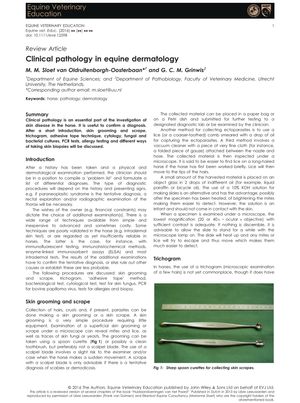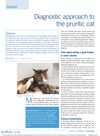Clinical Pathology in Equine Dermatology
June 2016
in “
Equine Veterinary Education
”
skin scrapes trichograms cytology cultures PCR tests allergy testing biopsies fungal cultures bovine papilloma virus intradermal tests serum tests pyoderma bacteriological examination fine needle aspiration biopsy punch biopsy incision biopsy excision biopsy skin scraping hair analysis cell study bacterial culture polymerase chain reaction tests allergy tests skin biopsy fungal test BPV skin allergy test blood allergy test skin infection bacterial test needle biopsy small skin sample cut biopsy full skin removal biopsy

TLDR The document concludes that using the right diagnostic methods and careful sample handling is crucial for accurately diagnosing horse skin diseases.
The document from 2016 highlights the role of clinical pathology in diagnosing skin diseases in horses, outlining various diagnostic methods such as skin scrapes, trichograms, cytology, cultures, PCR tests, allergy testing, and biopsies. It stresses the importance of proper sample collection and handling to prevent false results, especially in fungal cultures and PCR tests for bovine papilloma virus. Allergy diagnosis in horses remains challenging due to unreliable intradermal and serum tests. For persistent pyoderma, bacteriological examination is advised. The document also details biopsy techniques, noting that the choice of method should be based on the specific skin condition. Fine needle aspiration biopsy is less invasive but not suitable for all conditions, while punch, incision, and excision biopsies are recommended for various diagnoses, with careful handling and detailed case information necessary for accurate pathology results. No funding sources or conflicts of interest were reported for this review article.




